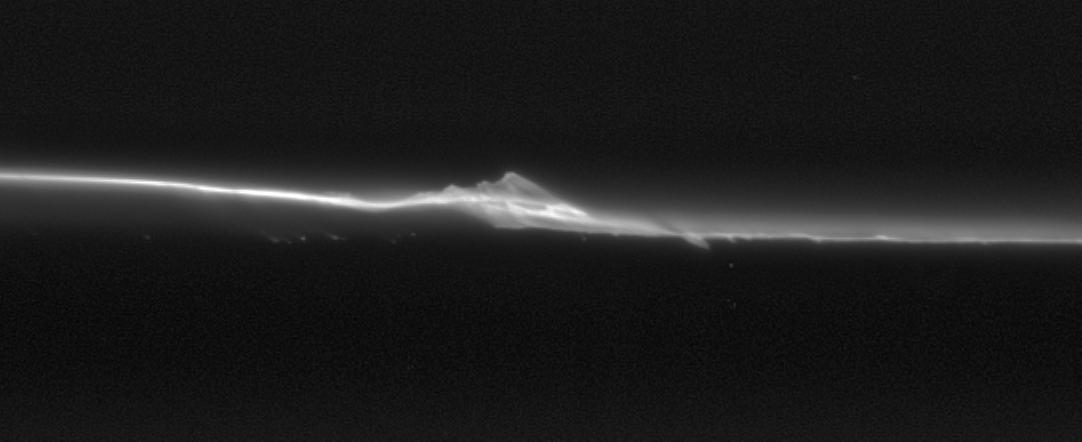Source: http://www.boston.com/bigpicture/2009/10/saturn_at_equinox.html
From 20 degrees above the ring plane, Cassini's wide angle camera shot 75 exposures in succession for this mosaic showing Saturn, its rings, and a few of its moons a day and a half after exact Saturn equinox, when the sun's disk was exactly overhead at the planet's equator. The images were taken on Aug. 12, 2009, at a distance of approximately 847,000 km (526,000 mi) from Saturn. (NASA/JPL/Space Science Institute)

Rays of light from the sun have taken many different paths to compose this image of Saturn and its rings. This view looks toward the unilluminated (north) side of the rings and, at the top of the image, the night side of Saturn. Sunlight has been reflected off the illuminated side of the rings to light the planet's southern hemisphere, seen here as a bright band of yellow-orange. The northern hemisphere, in the top left corner of the image, is dimly lit by light diffusely scattered through the rings. The planet's shadow cuts across the rings, but light reflected off the southern hemisphere backlights parts of the C ring, making them visible in silhouette. (NASA/JPL/Space Science Institute) #

The moon Prometheus and its nearby disturbance of Saturn's F ring. Prometheus periodically gores the F ring, drawing out streamers of material from the ring. The image was taken in visible light at a distance of approximately 950,000 km (590,000 mi) from Saturn. (NASA/JPL/Space Science Institute) #

This animated series of images of Saturn's F Ring was acquired by Cassini on June 10, 2009. Shepherd moons Prometheus (inner) and Pandora (outer) pass by, alternately smoothing and disturbing the particles that make up the ring. Kinks, knots, wakes and disturbances are apparent in the thin ring as it rotates. (NASA/JPL/Space Science Institute) #

From 20 degrees above the ring plane, Cassini's wide angle camera shot 75 exposures in succession for this mosaic showing Saturn, its rings, and a few of its moons a day and a half after exact Saturn equinox, when the sun's disk was exactly overhead at the planet's equator. The images were taken on Aug. 12, 2009, at a distance of approximately 847,000 km (526,000 mi) from Saturn. (NASA/JPL/Space Science Institute)

Rays of light from the sun have taken many different paths to compose this image of Saturn and its rings. This view looks toward the unilluminated (north) side of the rings and, at the top of the image, the night side of Saturn. Sunlight has been reflected off the illuminated side of the rings to light the planet's southern hemisphere, seen here as a bright band of yellow-orange. The northern hemisphere, in the top left corner of the image, is dimly lit by light diffusely scattered through the rings. The planet's shadow cuts across the rings, but light reflected off the southern hemisphere backlights parts of the C ring, making them visible in silhouette. (NASA/JPL/Space Science Institute) #

The moon Prometheus and its nearby disturbance of Saturn's F ring. Prometheus periodically gores the F ring, drawing out streamers of material from the ring. The image was taken in visible light at a distance of approximately 950,000 km (590,000 mi) from Saturn. (NASA/JPL/Space Science Institute) #

This animated series of images of Saturn's F Ring was acquired by Cassini on June 10, 2009. Shepherd moons Prometheus (inner) and Pandora (outer) pass by, alternately smoothing and disturbing the particles that make up the ring. Kinks, knots, wakes and disturbances are apparent in the thin ring as it rotates. (NASA/JPL/Space Science Institute) #

Last edited:





